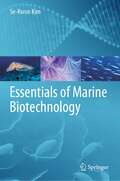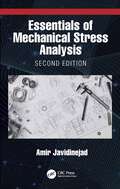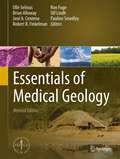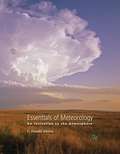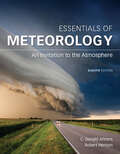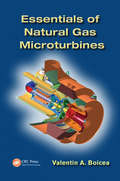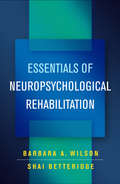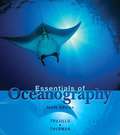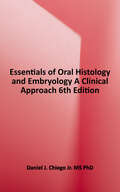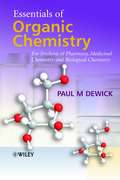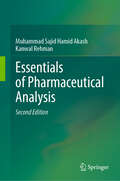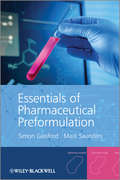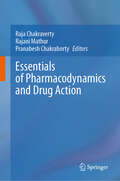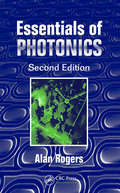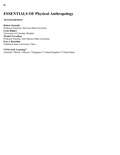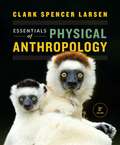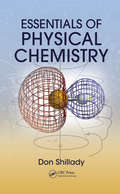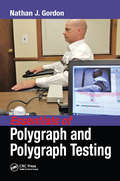- Table View
- List View
Essentials of Laboratory Animal Science: Principles and Practices
by Ramesh Srinivasan P. Nagarajan Ramachandra GuddeThis book comprehensively reviews the anatomy, physiology, genetics and pathology of laboratory animals as well as the principles and practices of using laboratory animals for biomedical research.It covers the design of buildings used for laboratory animals, quality control of laboratory animals, and toxicology, and discusses various animal models used for human diseases. It also highlights aspects, such as handling and restraint and administration of drugs, as well as breeding and feeding of laboratory animals, and provides guidelines for developing meaningful experiments using laboratory animals.Further, the book discusses various alternatives to animal experiments for drug and chemical testing, including their advantages over the current approaches. Lastly, it examines the potential effect of harmful pathogens on the physiology of laboratory animals and discusses the state of art in in vivo imaging techniques.The book is a useful resource for research scientists, laboratory animal veterinarians, and students of laboratory animal medicine.
Essentials of Marine Biotechnology
by Se-Kwon KimThis textbook introduces marine biotechnology by collecting the key knowledge on genetics, fish breeding, genetic diversity, seaweed production and microalgae biotechnology, and explores marine biomaterials and how they can benefit human health. Covering the latest applications of marine biotechnology in natural product development, genomics, transgenic technology, cosmeceuticals, nutraceuticals, and pharmaceutical development, it particularly focuses on future biological resources, developing functional materials from marine life, production of marine bioenergy and marine microbial resources and biotechnology. The author explains the structure of the book in an introductory note, and each chapter offers a detailed overview and conclusion to help readers better grasp the acquired knowledge. Lastly, the final part provides a comprehensive glossary with brief explanations of the key concepts in marine biotechnology. Written by a leading expert in the field with more than 30 years of teaching experience, this book broadens students’ understanding of the basics and recent developments in marine biotechnology.
Essentials of Mechanical Stress Analysis (Mechanical And Aerospace Engineering Ser.)
by Amir JavidinejadEssentials of Mechanical Stress Analysis, updated for the second edition, covers stress analysis from an interdisciplinary perspective. Discussing techniques and theories essential to analysing structures, the book covers both analytical and numerical approaches. The second edition adds new topics and updates research to follow current advances in the field. New sections on material properties, composite materials and finite element analysis enable the reader to further establish the fundamental theory behind material behaviour and the causes of stress and strain. Also covering beams, plates, columns and elastic instability, the book discusses fatigue, life cycle, energy methods and MathCAD sample code. As a clear and comprehensive guide to stress and structural analysis, this book is relevant to students and scholars in the fields of mechanical, aerospace and civil engineering, as well as materials science.
Essentials of Medical Geology
by Olle Selinus Brian Alloway Jose Centeno Pauline Smedley Robert Finkelman Ron Fuge Ulf LindhEssentials of Medical Geology reviews the essential concepts and practical tools required to tackle environmental and public health problems. It is organized into four main sections. The first section deals with the fundamentals of environmental biology, the natural and anthropogenic sources of health elements that impact health and illustrate key biogeochemical transformations. The second section looks at the geological processes influencing human exposure to specific elements, such as radon, arsenic, fluorine, selenium and iodine. The third section presents the concepts and techniques of pathology, toxicology and epidemiology that underpin investigations into the human health effects of exposure to naturally occurring elements. The last section provides a toolbox of analytical approaches to environmental research and medical geology investigations. Essentials of Medical Geology was first published in 2005 and has since won three prestigious rewards. The book has been recognized as a key book in both medical and geology fields and is widely used as textbook and reference book in these fields. For this revised edition, editors and authors have updated the content that evolved a lot during 2005 and added two new chapters, on public health, and agriculture and health. This updated volume can now continue to be used as a textbook and reference book for all who are interested in this important topic and its impacts the health and wellbeing of many millions of people all over the world. · Addresses key topics at the intersection of environmental science and human health · Developed by 60 international experts from 20 countries and edited by professionals from the International Medical Geology Association (IMGA) · Written in non-technical language for a broad spectrum of readers, ranging from students and professional researchers to policymakers and the general public · Includes color illustrations throughout, references for further investigation and other aids to the reader
Essentials of Mesenchymal Stem Cell Biology and Its Clinical Translation
by Robert Chunhua ZhaoMesenchymal stem cells (MSCs), a type of adult stem cells, have attracted the attention of scientists and physicians alike due to their unique biological properties and potential for disease treatment. As stem cell research is complex and progressing rapidly, it is important that the experts in this field share their views and perspectives. This book, co-edited by leading global researchers, is divided into three major sections and covers a broad range of topics concerning MSCs during their transition from benchside to bedside. The book is intended for researchers and clinicians in the field of stem cells. Dr. Robert Chunhua Zhao, MD. Ph.D is Cheung Kong Professor of Stem Cell Biology, Professor of Cell Biology at the Institute of Basic Medical Sciences & School of Basic Medicine, Chinese Academy of Medical Sciences & Peking Union Medical College, China Director of Center for Tissue Engineering, PUMC Chief scientist of 973 program Regional Editor of Stem Cells and Development.
Essentials of Meteorology: An Invitation to the Atmosphere
by C. Donald AhrensThis updated and enhanced seventh edition of ESSENTIALS OF METEOROLOGY is written by the most widely read and authoritative author in introductory meteorology-Donald Ahrens. Ahrens's ability to explain relatively complicated ideas in a student-friendly, manageable fashion allows even non-science students to visualize the principles of meteorology. The text's clear and inviting narrative is supplemented by numerous pedagogical features that encourage observing, calculating, and synthesizing information. New critical thinking questions linked to key figures and concept animation boxes point to online animations and appendices allowing students to immediately apply the text material to the world around them--and understand the underlying meteorological principles.
Essentials of Meteorology: An Invitation to the Atmosphere (Mindtap Course List Series)
by Robert Henson C. Donald AhrensESSENTIALS OF METEOROLOGY, 8th Edition, is written for students interested in gaining insights into the dynamic workings of the atmosphere. The authors' ability to explain relatively complicated ideas in an easy-to-understand way lets both science and nonscience majors visualize the principles of meteorology.
Essentials of Natural Gas Microturbines
by Valentin A. BoiceaAddressing a field which, until now, has not been sufficiently investigated, Essentials of Natural Gas Microturbines thoroughly examines several natural gas microturbine technologies suitable not only for distributed generation but also for the automotive industry. An invaluable resource for power systems, electrical, and computer science engineers
Essentials of Neuropsychological Rehabilitation
by Barbara A. Wilson Shai BetteridgeFor people with disabilities caused by nonprogressive brain injury, challenges in everyday living can be multifaceted and overwhelming. This book presents key principles of holistic neuropsychological rehabilitation, helping practitioners stay on track through complex terrain. Leading authorities Barbara A. Wilson and Shai Betteridge provide a framework for effective intervention based on a collaborative understanding of clients' strengths and needs. They describe essential strategies for assessing and remediating the impact of cognitive and psychosocial problems in everyday life. Detailed case examples illustrate the process of building partnerships with families, setting meaningful goals, developing skills and supports, and addressing emotional and mental health concerns. Innovative uses of technology are highlighted. Several reproducible clinical tools can be downloaded and printed in a convenient 8 1/2" x 11" size.
Essentials of Neuropsychology: Integrating Eastern and Western Perspectives
by K. Jayasankara ReddyThis comprehensive textbook offers a holistic integration of both the research and clinical aspects of neuropsychology. Combining Eastern and Western perspectives, it explores latest developments, current scope, and significant challenges in the field to provide a detailed understanding of brain and behavior from research and intervention methods to rehabilitation and applications. Each chapter in the book includes an introduction to the topic, an overview of the latest research in the field, and a discussion of the future directions that research can take. The book is structured into three parts, each addressing specific aspects of the field. Part 1 introduces the readers to the fundamental principles of neuropsychology, including the available methods of assessment, brain anatomy, and its connection with human psychology. It provides an indepth look at neuropsychological and electrophysiological methods and their applications in clinical practice. Part 2 focuses on the brain and cognition, examining the complex mechanisms that underlie cognitive behavior. The chapters include neuropsychology of various executive functions, memory, and social cognition. Part 3 delves into clinical disorders and their biological basis. This section explores the disorders that have a direct relationship between brain functioning and behavior, offering valuable insights into their diagnosis, treatment, and management. It is an essential resource for both students in clinical neuropsychology and professionals seeking to expand their knowledge and stay abreast of the latest developments.
Essentials of Oceanography (10th edition)
by Harold V. Thurman Alan P. TrujilloTrujillo and Thurman present in-depth discussions of oceanographic concepts and demystify the science even for non-science students. Their systems approach highlights the relationship between oceanographic phenomena and how those phenomena affect other Earth systems. Scientific information from geology, chemistry, physics, and biology combine to illustrate how each of these disciplines relates to the ocean.
Essentials of Oral Histology and Embryology: A Clinical Approach, 6th Edition
by Daniel J. ChiegoEssentials of Oral Histology and Embryology: A Clinical Approach, 6th Edition uses a patient-centered approach to help dental professionals build a strong foundation in oral biology and basic science. It provides clear explanations of the anatomy of oral and facial tissues - and normal and abnormal orofacial development - so that you can provide effective oral health care for all patients. In addition to the stages of tooth development, it covers eruption and shedding of teeth, plus the parts of teeth - including enamel, dentin, dental pulp, and cementum. Written by Daniel J. Chiego, Jr., a noted dental educator and researcher, this book gives you the knowledge you need to succeed in the classroom and in clinical practice. Cutting-edge content provides essential knowledge of the basics of oral biology with a focus on practical clinical application. Clinical Comment, Consider the Patient, Quandaries in Science, and Case Study boxes apply scientific content to everyday dental practice and explore the boundaries of scientific research. Self-evaluation questions and practice quizzes help you prepare for classroom and national board exams. NEW! Coverage of COVID-19 includes how the virus affects the oral cavity. Updated full-color illustrations, micrographs, and histographs add to the already robust art program that supplements content by depicting various stages within the development of oral structures.
Essentials of Organic Chemistry
by Paul M. DewickEssentials of Organic Chemistry is an accessible introduction to the subject for students of Pharmacy, Medicinal Chemistry and Biological Chemistry. Designed to provide a thorough grounding in fundamental chemical principles, the book focuses on key elements of organic chemistry and carefully chosen material is illustrated with the extensive use of pharmaceutical and biochemical examples.In order to establish links and similarities the book places prominence on principles and deductive reasoning with cross-referencing. This informal text also places the main emphasis on understanding and predicting reactivity rather than synthetic methodology as well as utilising a mechanism based layout and featuring annotated schemes to reduce the need for textual explanations.* tailored specifically to the needs of students of Pharmacy Medical Chemistry and Biological Chemistry* numerous pharmaceutical and biochemical examples* mechanism based layout* focus on principles and deductive reasoningThis will be an invaluable reference for students of Pharmacy Medicinal and Biological Chemistry.
Essentials of Pericyclic and Photochemical Reactions
by Biswanath DindaThis book provides a concise introduction to pericyclic and photochemical reactions for organic synthesis. In the first part about pericyclic reactions, the author explains electrocyclic reactions, cycloaddition reactions, sigmatropic rearrangements, and group transfer reactions. The second part on photochemistry is dedicated to photochemical reactions of a variety of compound classes, including alkenes, dienes, and polyenes, carbonyl compounds, and aromatic compounds. Additionally, photofragmentation reactions are described in a dedicated chapter. The last chapter gives an outlook on applications of photochemistry and natural photochemical phenomena. Both parts start with a comprehensive presentation of the general principles of the pericyclic and photochemical reactions. All chapters are rich in examples, which help illustrate the explained principles and establish ties to results and trends in recent research. Additionally, each chapter offers exercises for students, and solutions to the problems are provided in a separate appendix. This book nicely illustrates the utility of pericyclic and photochemical reactions and provides students and researchers with the tools to apply them routinely for an efficient synthesis of complex organic molecules. It will therefore appeal to advanced undergraduate students, graduate and postgraduate students, and even to practitioners and scientists in the field of organic synthesis. The rich examples and exercises will also make it a versatile tool for teachers and lecturers.
Essentials of Pharmaceutical Analysis
by Kanwal Rehman Muhammad Sajid AkashRecent advances in the pharmaceutical sciences and biotechnology have facilitated the production, design, formulation and use of various types of pharmaceuticals and biopharmaceuticals. This book provides detailed information on the background, basic principles, and components of techniques used for the analysis of pharmaceuticals and biopharmaceuticals. Focusing on those analytical techniques that are most frequently used for pharmaceuticals, it classifies them into three major sections and 19 chapters, each of which discusses a respective technique in detail. Chiefly intended for graduate students in the pharmaceutical sciences, the book will familiarize them with the components, working principles and practical applications of these indispensable analytical techniques.
Essentials of Pharmaceutical Analysis
by Kanwal Rehman Muhammad Sajid AkashThis 2nd edition of the comprehensive resource on pharmaceutical analysis and analytical techniques builds upon the success of its first edition by incorporating updated methodologies, expanded content, and fresh insights into modern practices. Designed for students, researchers, and industry professionals alike, the book bridges theoretical principles with practical applications, covering both classical methods and innovative approaches across spectrophotometry, chromatography, mass spectrometry, and thermal analysis. Detailed chapters elucidate method development, instrumentation, quality control, and regulatory compliance, while enriched case studies and examples from environmental science, biomedical research, and materials science illustrate real-world applications. New sections highlight the integration of miniaturized instruments, hyphenated techniques, and computational tools including machine learning and cloud-based analytics. Enhanced diagrams, tables, and summaries further facilitate the understanding of complex analytical concepts. This edition not only reinforces essential foundational knowledge but also equips readers with advanced practical skills to meet evolving challenges in pharmaceutical research and quality assurance. Whether you are seeking a solid academic grounding or aiming to adopt cutting-edge techniques, this book provides an indispensable guide to mastering contemporary pharmaceutical analysis and the future of analytical chemistry. With its rigorous and accessible approach, this book serves as an essential reference that inspires innovation in analytical sciences.
Essentials of Pharmaceutical Preformulation
by Simon Gaisford Mark SaundersEssentials of Pharmaceutical Preformulation is a study guide which describes the basic principles of pharmaceutical physicochemical characterisation. Successful preformulation requires knowledge of fundamental molecular concepts (solubility, ionisation, partitioning, hygroscopicity and stability) and macroscopic properties (physical form, such as the crystalline and amorphous states, hydrates, solvates and co-crystals and powder properties), familiarity with the techniques used to measure them and appreciation of their effect on product performance, recognising that often there is a position of compromise to be reached between product stability and bioavailability.This text introduces the basic concepts and discusses their wider implication for pharmaceutical development, with reference to many case examples of current drugs and drug products. Special attention is given to the principles and best-practice of the analytical techniques that underpin preformulation (UV spectrophotometry, TLC, DSC, XRPD and HPLC). The material is presented in the typical order that would be followed when developing a medicine and maps onto the indicative pharmacy syllabus of the Royal Pharmaceutical Society of Great BritainUndergraduate-level pharmacy students and R&D / analytical scientists working in the pharmaceutical sector (with or without a pharmaceutical background) will find this text easy to follow with relevant pharmaceutical examples.Essential study guide for pharmacy and pharmaceutical science studentsCovers the pharmaceutical preformulation components of the Royal Pharmaceutical Society of Great Britain's indicative syllabusEasy to follow text highlighted with relevant pharmaceutical examplesSelf-assessment assignments in a variety of formatsWritten by authors with both academic and industrial experienceCompanion website with further information to maximise learning
Essentials of Pharmacodynamics and Drug Action
by Raja Chakraverty Rajani Mathur Pranabesh ChakrabortyThe book provides a comprehensive exploration of the dynamic field of pharmacology and its fundamental principles. It delves into the intricate interactions between drugs and the human body, focusing on pharmacokinetics, which explains the dynamics of drug actions in the body, and pharmacodynamics, which uncovers the mechanisms through which drugs exert their effects. The book also emphasizes the crucial aspects of therapeutics and gene-based therapy, shedding light on modern approaches to disease treatment. Readers will gain insights into drugs that target the autonomic nervous system, influencing functions beyond voluntary control, and drugs that act on the central nervous system, impacting neurological processes. Additionally, the book examines medications affecting renal and cardiovascular functions, playing a significant role in maintaining homeostasis. Moreover, it explores the realm of drugs influencing gastrointestinal function, essential for digestive health.Furthermore, the book covers pharmacotherapy for microbial diseases, addressing the challenge of infectious agents and their treatment. It also investigates hormones and hormone antagonists, pivotal in regulating various physiological processes. Lastly, it provides a comprehensive understanding of drugs used for immunomodulation, which plays a crucial role in enhancing or suppressing the immune system.The book serves as a resource for students, researchers, and healthcare professionals seeking a deep understanding of drug interactions, therapeutic applications, and cutting-edge approaches in pharmacology.
Essentials of Photonics (Second Edition)
by Alan Rogers<p>The importance of photonics in science and engineering is widely recognized and will continue to increase through the foreseeable future. In particular, applications in telecommunications, medicine, astronomy, industrial sensing, optical computing and signal processing continue to become more diverse. <p>Essentials of Photonics, Second Edition describes the entire range of photonic principles and techniques in detail. Previously named Essentials of Optoelectronics, this newly named second edition of a bestseller felects changes that have occurred in this field. The book presents a new approach that concentrates on the physical principbestles, demonstrating their interdependence, and developing them to explain more complex phenomena. It gives insight into the underlying physical processes in a way that is readable and easy to follow, as well as entirely self-contained. <p>Written by an author with many years of experience in teaching and research, this book includes a detailed treatment of lasers, waveguides (including optical fibres), modulators, detectors, non-linear optics and optical signal processing. This new edition is brought up-to-date with additional sections on photonic crystal fibres, distributed optical-fibre sensing, and the latest developments in optical-fibre communications.</p>
Essentials of Physical Anthropology
by Robert Jurmain Lynn Kilgore Wenda Trevathan Eric BartelinkConcise, well-balanced, and comprehensive, ESSENTIALS OF PHYSICAL ANTHROPOLOGY, 10th Edition, introduces you to physical anthropology with the goal of helping you understand why it is important to know about human evolution. <p><p>You'll learn how humans are biologically connected to all other life, including our ancient ancestors and our contemporary primate cousins, and how closely modern human populations are related to each other. Numerous high-quality visual diagrams, artwork, maps, photographs, and other learning tools will help you grasp the big picture of human evolution.
Essentials of Physical Anthropology: Discovering Our Origins (Third Edition)
by Clark Spencer LarsenThe big picture of physical anthropology. Essentials of Physical Anthropology, Third Edition, is rich with stunning and photorealistic art, thoughtful pedagogy, innovative media, and up-to-date, student-centered content that illuminate physical anthropology’s most important themes.
Essentials of Physical Chemistry
by Don ShilladyAt a time when U.S. high school students are producing low scores in mathematics and science on international examinations, a thorough grounding in physical chemistry should not be considered optional for science undergraduates. Based on the author's thirty years of teaching, Essentials of Physical Chemistry merges coverage of calculus with chemist
Essentials of Polygraph and Polygraph Testing
by Nathan J. GordonThroughout history, there has been an intrinsic need for humans to detect deception in other humans. Developed in 1923, the polygraph machine was a tool designed to do just this. To date, there have been many improvements made to the basic polygraph instrument. This book outlines the instrumentation as well as the latest in questioning techniques and methods available to the professional interviewer to determine truth from deception. The book covers psychology and physiology, a history of polygraph with the advances of leading figures, question formulation, data analysis, legal implications and legal cases, and the author’s developed technique Integrated Zone Comparison Technique (IZCT).
Essentials of Radiation Heat Transfer (Ane/athena Bks.)
by C. BalajiEssentials of Radiation Heat Transfer focuses only on the essential topics required to gain an understanding of radiation heat transfer to enable the reader to master more challenging problems. The strength of the book lies in its elaborate presentation of the powerful radiosity-irradiation method and shows how this technique can be used to solve a variety of problems of radiation in enclosures made of one to any number of surfaces in both transparent and participating media. The book also introduces atmospheric radiation in which engineers can contribute to the technology of remote sensing and atmospheric sciences in general, by a better understanding of radiation.The author has included pedagogical features such as end-of-chapter exercises and worked examples with varying degrees of difficulty to augment learning and self-testing. The book has been written in an easy- to- follow conversational style to enhance reader engagement and learning outcomes. This book will be a useful guide for upper undergraduate and graduate students in the areas of mechanical engineering, aerospace engineering, atmospheric sciences, and energy sciences.
Essentials of Radiologic Science
by Denise OrthWhile maintaining the focused, student-friendly approach this title is known for, the updated 2nd Edition of Essentials of Radiologic Science now adds more detail and context on key topics to better meet the needs of today’s classroom. Designed throughout to help students succeed in the course and begin preparing for the ARRT examination from the very beginning of their program, the 2nd Edition now includes comprehensive coverage of digital imaging, an array of in-book and online learning tools to help students of all learning styles master the content, and a powerful suite of online instructor’s resources.

